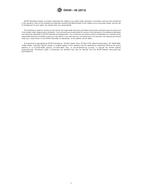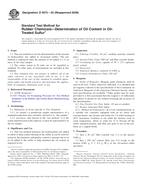Potřebujeme váš souhlas k využití jednotlivých dat, aby se vám mimo jiné mohly ukazovat informace týkající se vašich zájmů. Souhlas udělíte kliknutím na tlačítko „OK“.
ASTM D4528-88(2012)
Standard Classification for Rubber Compounding Materials—Sulfur
Automaticky přeložený název:
Standardní klasifikace gumárenských slučování materiály & ndash; Síra
NORMA vydána dne 1.5.2012
Informace o normě:
Označení normy: ASTM D4528-88(2012)
Poznámka: NEPLATNÁ
Datum vydání normy: 1.5.2012
Kód zboží: NS-27593
Počet stran: 3
Přibližná hmotnost: 9 g (0.02 liber)
Země: Americká technická norma
Kategorie: Technické normy ASTM
Kategorie - podobné normy:
Anotace textu normy ASTM D4528-88(2012) :
Keywords:
insoluble sulfur, rhombic sulfur, sulfur , Chemical analysis--rubber chemicals/materials, Classification (standards)--rubber, Insoluble matter content--rubber, Rhombic sulfur, Rubber compounding materials, Sulfur--rubber, ICS Number Code 83.040.20 (Rubber compounding ingredients)
Doplňující informace
| Significance and Use | ||||||||||||
|
Sulfur is one of the principal rubber vulcanizing agents. It is a critical additive. When chemically combined with rubber, sulfur develops basic performance properties in the vulcanized compound such as: tensile strength, elongation, modulus, and hardness. In soft or elastic rubber compounds, sulfur is an essential but minor additive. In semi-hard rubber and ebonite, sulfur becomes a major compounding material while retaining its role as a vulcanizing agent. The most stable molecular form of sulfur at ambient conditions is a ring structure containing eight sulfur atoms. Depending on conditions these molecules orient into one of two crystalline structures. At room temperature the crystals are rhombic and above 95°C they rearrange to monoclinic. Less than 1.5 % of either crystalline structure of sulfur is soluble in any rubber at room temperature. The second common molecular form of sulfur is polymeric sulfur, made up of unbranched chains of sulfur atoms. It is commonly referred to in the rubber industry as insoluble sulfur. When this material is created by rapid heating to above 160°C and quenching to room temperature, the sulfur is amorphous. If formed under other conditions, the polymer chains may develop regions of pseudo crystallinity. Insoluble sulfur is an important form of sulfur used only in the rubber industry. It is not soluble in any type of rubber hydrocarbon. When it is mixed in rubber, it disperses but remains undissolved in the rubber. The use of insoluble sulfur prevents the development of a supersaturated solution of sulfur in rubber that occurs when rhombic sulfur is used. No sulfur bloom will develop on the surface of uncured rubber pieces when the rubber cools after mixing or processing; therefore, building tack is preserved. At curing temperatures, insoluble sulfur rapidly transforms to a soluble species, dissolves in the rubber, and enters into the vulcanization process. |
||||||||||||
| 1. Scope | ||||||||||||
|
1.1 This classification covers the variety of sulfur grades used in the rubber industry. Typical chemical and physical properties for sulfur are shown. Sulfur is principally used in unsaturated rubbers as a vulcanizing agent. |
||||||||||||
| 2. Referenced Documents | ||||||||||||
|
Podobné normy:
Historická
1.5.2012
Historická
1.5.2011
Historická
1.5.2012
Historická
1.5.2012
Historická
1.1.2009
Historická
1.5.2012
Doporučujeme:
EviZak - všechny zákony včetně jejich evidence na jednom místě
Poskytování aktuálních informací o legislativních předpisech vyhlášených ve Sbírce zákonů od roku 1945.
Aktualizace 2x v měsíci !
Chcete vědět více informací? Podívejte se na tuto stránku.



 ASTM D4315-94(2012)..
ASTM D4315-94(2012).. ASTM D4527-99(2011)..
ASTM D4527-99(2011).. ASTM D4569-06(2012)..
ASTM D4569-06(2012).. ASTM D4571-06(2012)..
ASTM D4571-06(2012).. ASTM D4573-03(2009)..
ASTM D4573-03(2009).. ASTM D4574-06(2012)..
ASTM D4574-06(2012)..
 Cookies
Cookies
